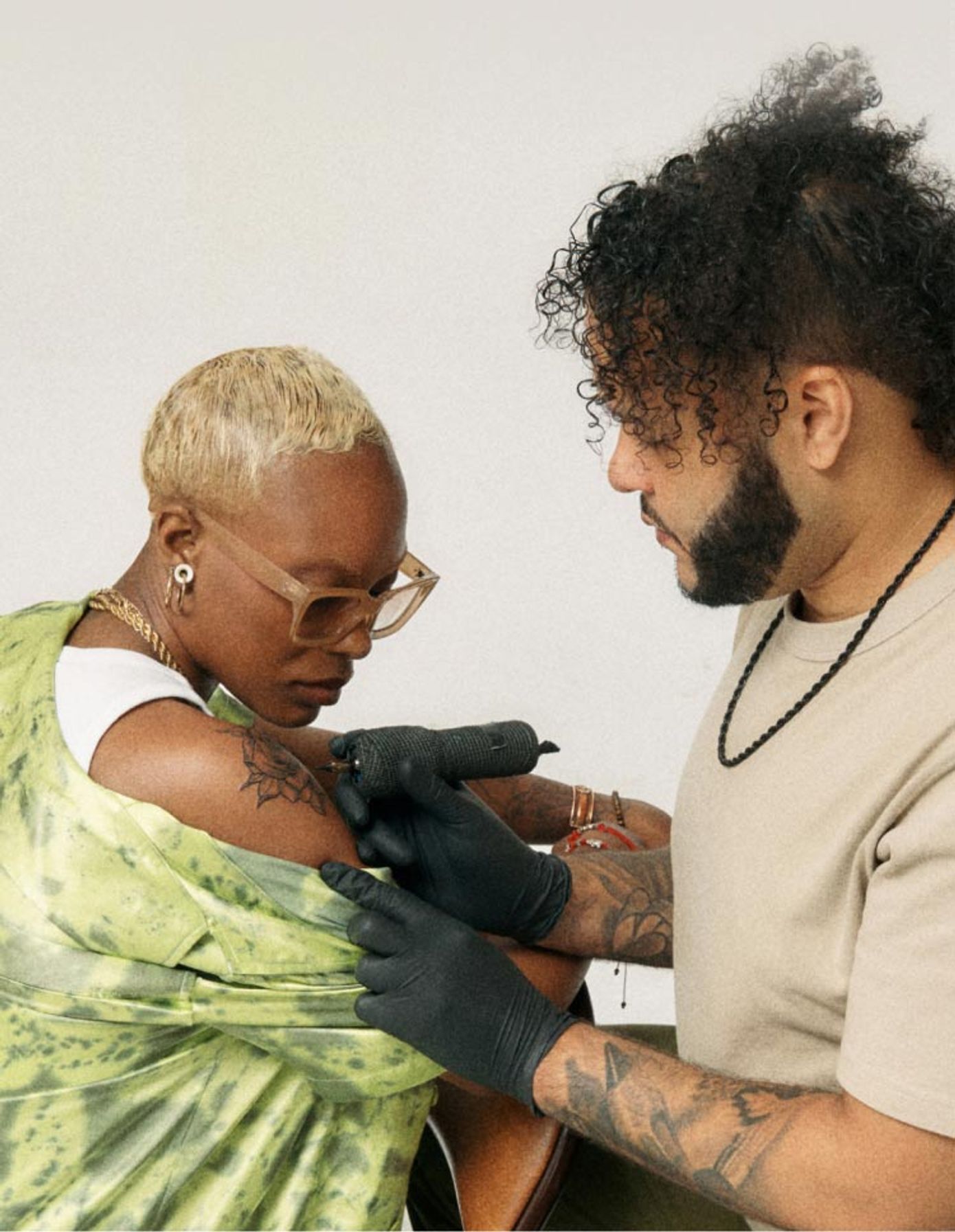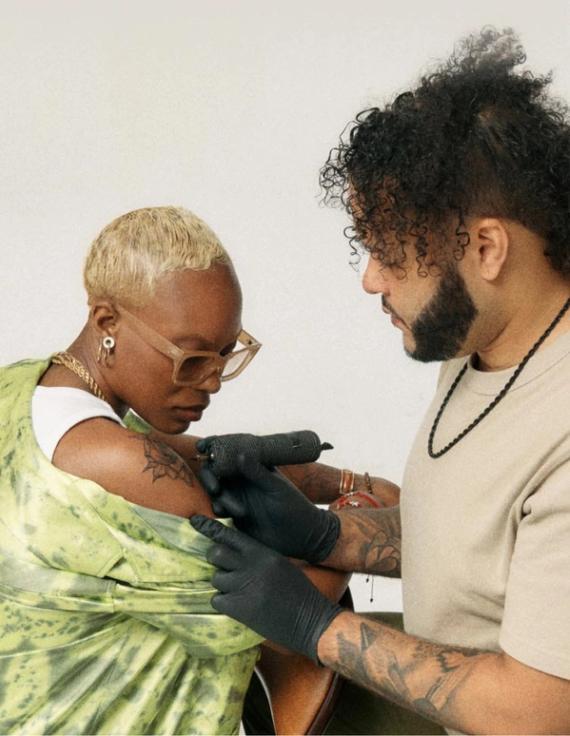

The Ultimate Guide to Getting Your First Tattoo


A lot of what-ifs might be swirling around the idea of your first tattoo: What if it hurts so much that I have to stop halfway through? What if I don’t like how it comes out and I’m stuck with this tattoo for life? What if I eventually fall out of love with the tattoo I want so desperately right now?
Getting your first tattoo should feel thrilling and self-affirming. But in reality people getting their first tattoos might have some anxiety. (Understandably.) We’re here to help. We’ve assembled some tips and guidance in the hopes of making your first tattoo a smoother process from start to finish.
Picking a Tattoo Design and Style
You have nearly infinite options for the style of your first tattoo. The most important question is: what feels right for your personal aesthetic?. For starters, here are some prominent, popular styles you should know about when considering your first tattoo:
American Traditional: This style is as classic as they come. It’s defined by bold, black outlines and minimal shading. Common imagery includes swallows, anchors, skulls, eagles, and hearts. Think Rockabilly.
Realism: It’s mind-blowing what tattoo artists can do today with photorealistic imagery. If you’re looking for an intricate, hyper-realistic image for your first tattoo, this is the style for you.
Illustrative: These tattoos combine elements of traditional style and realism. They use solid black outlines and minimal shading to keep the imagery sharp while maintaining the appearance of an illustration, as opposed to a photograph.
Geometric: These simple designs are based on common shapes. They’re usually abstract and drawn with thin, intricate lines.
Minimalist: A minimalist tattoo is a common choice for people getting their first tattoos because they’re often small and use simple, clean lines and incorporate lots of negative space.
Choosing the Best Placement for Your First Tattoo
The placement of your new tattoo depends on several factors:
Size: How big do you want your tattoo to be? Areas like your back and thighs provide space for a large, detailed design, while your ankle is a good place for a small, simple piece.
Visibility: Do you want the option to hide your tattoo? A tattoo on your wrist or forearm will get much more attention than one placed on your back or thigh. Some people are looking to make a statement, but others might want to be more discreet with their first tattoo. Think about what areas of skin will be exposed as your wardrobe changes with the seasons.
Pain: Everyone has different pain levels, but generally, areas where skin is closer to the bone will be more painful places to get tattooed. Those are places like the wrists, ankles, ribs, back of the neck, and over the spine. Tattoos on parts of your body with more fat like your biceps, forearms, and outer thighs tend to hurt less. And another thing to remember: the pain is temporary. If you have some pain tolerance, don’t rule out a tattoo on your ankle if that’s what you really want.
How to Prepare For Your First Tattoo
There are some things you can and should do as you head into your first appointment:
Eat something light and hydrate before you arrive at your tattoo appointment. If you feel lightheaded during the process, let your artist know.
Wear comfortable clothes. The more relaxed you are, the more comfortable your tattoo experience will be. Looser clothing also makes it easier for you to try different placements. (ie. If you’re interested in a bicep tattoo, wear a short-sleeve shirt or tank top.)
Communicate with your tattoo artist. Be clear about what you like and don’t like about a specific design, and don’t be scared to ask if the size of your tattoo can be changed or if other alterations can be made. Speak up!
Once you’re done, talk to your artist about aftercare and follow their instructions. Your first tattoo is a special piece of art, and you want to take care of it—and your body—accordingly.
Here are some things to avoid:
Don’t take blood thinners, including Aspirin or Ibuprofen, for 24 hours before your appointment. These can cause excessive bleeding and can compromise the appearance of the tattoo.
Don’t drink alcohol excessively before showing up to your appointment. It has the same blood-thinning effect as many painkillers, which affects your aftercare experience.
Don’t apply numbing creams beforehand. They change the elasticity of your skin (i.e., it stretches and hardens) which can make the tattooing process difficult and affect the quality of your finished tattoo. We recommend talking with your tattoo artist about building in breaks and reminders to breathe along the way.
What to Expect From Your First Tattoo
On the day of your appointment, you’ll have to fill out some paperwork when you arrive at the studio. You’ll answer questions about your health history and sign consent forms. Important note: most tattoo studios require clients to be 18 years or older.
Once the paperwork is taken care of, your artist will take you back to their work station. They’ll use a safety razor to shave the area where you’re getting tattooed, and apply a temporary stencil of your design to make sure you’re happy with the placement and size. This step is important. If you’re not totally happy with how the stencil looks, now would be the time to make edits.
Once the stencil is applied, your artist will have you sit or lay down in a position that’s comfortable for you and makes the tattoo easy to apply. They’ll sterilize your skin before getting to work.
To keep your tattoo looking good and healing properly, be sure to talk with your tattoo artist about aftercare instructions for your specific tattoo.
Still Have Questions?
Wherever you are in the process, we’re here to help.
Ephemeral Tattoo offers a one-of-a-kind tattoo experience that’s perfect for tattoo first-timers: we use the traditional application process, but our patented ink is made-to-fade in about 9-15 months.
Even though a tattoo from Ephemeral won’t last a lifetime, we know that getting a tattoo is a commitment. Our artists are professionals and expert collaborators who will support you every step of the way. If you’re ready to get started, make a reservation